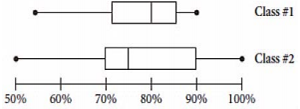Clusters should not be sorted from Major to Supporting and then taught in that order. To do so would strip the coherence of the mathematical ideas and miss the opportunity to enhance the major work of the grade with the supporting clusters.
-
Also Assesses:
- Assessment Limits :
N/A
- Calculator :
Neutral
- Context :
Required
MAFS.7.SP.2.3
- Test Item #: Sample Item 1
- Question:
Box plots for chapter 6 test scores of two classes are shown.

What is the difference in the median between the two sets of data?
- Difficulty: N/A
- Type: EE: Equation Editor
- Test Item #: Sample Item 2
- Question:
Survey data involving two random samples of students at a law school are shown. The surveys were taken comparing the age of students in 1990 to the age of students in 2014.

Select all the statements that are true about the two samples of students.
- Difficulty: N/A
- Type: SHT: Selectable Hot Text
Related Courses
Related Access Points
Related Resources
Formative Assessments
Lesson Plans
Perspectives Video: Professional/Enthusiasts
Problem-Solving Tasks
Virtual Manipulative
STEM Lessons - Model Eliciting Activity
This Model Eliciting Activity (MEA) presents students with the real-world problem of contaminated drinking water. Students are asked to provide recommendations for a non-profit organization working to help a small Romanian village acquire clean drinking water. They will work to develop the best temporary strategies for water treatment, including engineering the best filtering solution using local materials. Students will utilize measures of center and variation to compare data, assess proportional relationships to make decisions, and perform unit conversions across different measurement systems.
MFAS Formative Assessments
Students are asked to assess the validity of an inference regarding two distributions given their box plots.
Students are asked to use the mean and the mean absolute deviation (MAD) to compare two distributions.
Student Resources
Problem-Solving Task
In this task, students are able to conjecture about the differences and similarities in the two groups from a strictly visual perspective and then support their comparisons with appropriate measures of center and variability. This will reinforce that much can be gleaned simply from visual comparison of appropriate graphs, particularly those of similar scale.
Type: Problem-Solving Task
Virtual Manipulative
Users select a data set or enter their own data to generate a box plot.
Type: Virtual Manipulative
Parent Resources
Problem-Solving Task
In this task, students are able to conjecture about the differences and similarities in the two groups from a strictly visual perspective and then support their comparisons with appropriate measures of center and variability. This will reinforce that much can be gleaned simply from visual comparison of appropriate graphs, particularly those of similar scale.
Type: Problem-Solving Task









